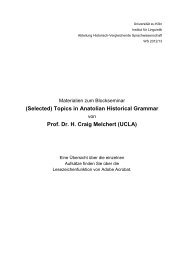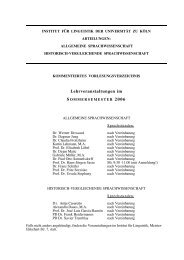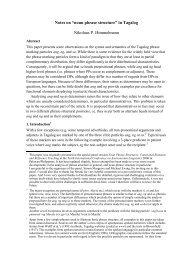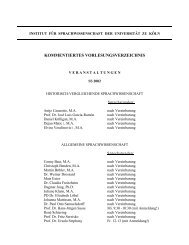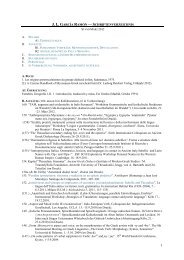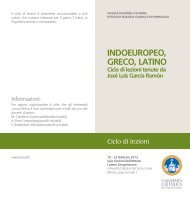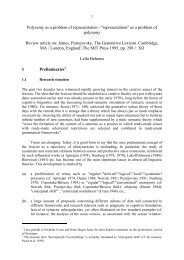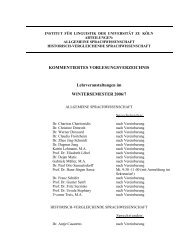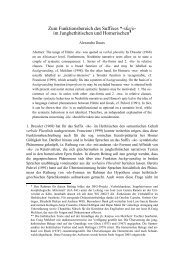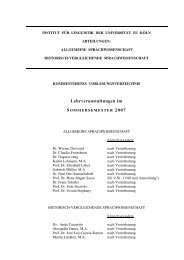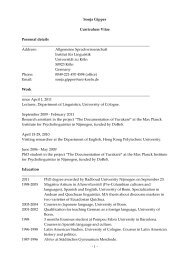Gesamtverzeichnis (pdf) - Institut für Linguistik - Universität zu Köln
Gesamtverzeichnis (pdf) - Institut für Linguistik - Universität zu Köln
Gesamtverzeichnis (pdf) - Institut für Linguistik - Universität zu Köln
You also want an ePaper? Increase the reach of your titles
YUMPU automatically turns print PDFs into web optimized ePapers that Google loves.
133. Kapitel „The Morphology of Greek“, in: Comparative Indo-European Linguistics (hrsg. von M. Fritz und J. S.<br />
Klein). Mouton de Gruyter, Berlin - New York (im Druck).<br />
132. „El antropónimo pilio e-ri-ko-wo y la fraseología poética: /Erikōwos/ (: μέγα κῶας Hom.+) o más bien<br />
/Erigowos/ (: μέγαν γόον HHCer., ἐρικλάγκταν γόον Pind. y μέγα βοήσας Hom. Ἐριβόας Pind.)“.<br />
Homenaje a Rosa A. Santiago (:Faventia 30–31, 2008–2009), Barcelona 2011, 33–45.<br />
131. (& Bruno Helly): „Deux nouvelles épiclèses dans des inscriptions de Larisa“. Mélanges Françoise Bader<br />
(im Druck).<br />
130. (& Bruno Helly): „Εννοδια Κορουταρρα ‘celle qui dote d’alimentation, de croissance‘ et autres divinités<br />
kourotrophes en Thessalie“. Revue de Philologie 80:2, 291–312.<br />
129. „Infinitifs et abstraits verbaux en indo-iranien: v.-av. xšąnmǝ̄ nē et sa préhistoire“. Zarathushtra entre l’Inde<br />
et l’Iran. Études indo-iraniennes et indo-européennes offertes à Jean Kellens à l’occasion de son 65e<br />
anniversaire, éd. par Éric Pirart et Xavier Tremblay, Beiträge <strong>zu</strong>r Iranistik XXX, Wiesbaden 2009, Dr.<br />
Ludwig Reichert Verlag, 79–93.<br />
128. „Primär- und Sekundärendungen im Konjunktiv im Vedischen: Deixis und Sprechakt“. Arbeitstagung der<br />
Indogermanischen Gesellschaft „Pragmatische Kategorien“ (FT Marburg, 24/26.9.2007). Wiesbaden<br />
2009, 79–91.<br />
127. „Altlatein cortumiō ‘Geländeausschnitt’, idg.*kr̥ -tomh1-ó- *‘(Schnitt) schneidend’, contemnō ‘schmähe’<br />
und griechisch κέρτομος ‘schmähend’, κερτομέω ‘schmähe’“. Aevum Antiquum 7, 2007, 285–298.<br />
126. „Mycenaean Onomastics, poetic phraseology and Indo-European comparison: the man’s name pu2-ke-qiri”.<br />
East and West (Papers in Indo-European Studies, Conference Kyoto University, 11–12.07. 2007<br />
hrsg. K.Yoshida and Br. Vine). Bremen 2009, 1–26.<br />
125. „Formal correspondences, different functions: on the reconstruction of inflectional categories of Indo-<br />
European“. Grammatical Change in Indo-European Languages (Papers presented at the Workshop on<br />
IE Linguistics at the XVIIIth International Conference on Historical Linguistics, Montreal 2007).<br />
Amsterdam, CILT 305, John Benjamins (in Memory of Carol Justus), 237–250.<br />
124. „Vergil und die indogermanische Dichtersprache“, in: Stefan Freund und Meinolf Vielberg (Hg.). Vergil und<br />
das antike Epos. Festschrift Hans-Jürgen Tschiedel. Tübingen: Franz Steiner, 2007, 267–278.<br />
123. „Espace réligieux, théonymes, epiclèses: à propos des nouveaux textes thébains“, in Isabelle Boehm et<br />
Sylvie Müller-Celka (eds.) Espace civil, espace réligieux en Égée durant la période mycénienne, Lyon,<br />
Travaux de la Maison de l´Orient et de la Méditerranée N° 54, 73–92.<br />
122. „On Polymorphic Presents in Rig Veda: Reduplication and ‘Aktionsart‘“. Proceedings of the Sanskrit World<br />
Conference Edinburgh, July 10–14, 2006, im Druck.<br />
121. „Idg. *(s)peh2- ‘in (heftige) Bewegung setzen, ziehen’: Ved. pā 3, heth. pipp(a)- ḫḫi und gr. σπάω, arm. hanem“.<br />
Akten der XII. Fachtagung der Indogermanischen Gesellschaft, Krakau 2004, im Druck.<br />
120. „Lexicographica Graeca: algunos nuevos lemmata a la luz de las glosas y la onomástica“. Myrtia 22, 2007,<br />
5–18.<br />
119. „Aus der Arbeit an einer Grammatik des Thessalischen: einige wichtige neue Verbalformen“. HS 120,<br />
2007, 195–208.<br />
118. „Latín templum: etimología y realia“. Donum amicitiae (Estudios en homenaje al Profesor Vicente Picón<br />
García. Madrid, UAM Ediciones, 2008, 117–32.<br />
117. „Préstamo o desarrollo paralelo en la fraseología poética: τέμενος αἰθέρος (Aesch.) y lat. caeli templa<br />
(Enn.+), templa aetheris (Sen.)“. De Grecia a Roma y de Roma a Grecia: un camino de ida y vuelta<br />
(eds. Á. Sánchez-Ostiz, J.B. Torres Guerra y R. Martínez ), Pamplona, EUNSA, 2007, 13–29.<br />
116. (& J.P. Olivier – M. Perna): „Scarabée avec inscription syllabique chypriote du premier millénaire au Musée<br />
Archéologique de Naples (Inv. 27001)“. CEEE, 36, 2006, 23–30.<br />
115. (& Br. Helly - A. Tzafalias): „Inscriptions inédites de Mopsion: décrets et dédicaces en dialecte thessalien“.<br />
Actes du Ve Congrès Interantional de Dialectologie grecque (Athen, 28.–30.10.2006). Athens 2007,<br />
63–103 (mit XIV Bildern).<br />
114. „A new Indo-European -u- present and a suppletive pair in Greek“. Verba docenti (Fs Jasanoff), Ann Arbor<br />
2007, 97–114.<br />
113. „Mykenische Personennamen und griechische Dichtung und Phraseologie: i-su-ku-wo-do-to und a-re-me-ne,<br />
a-re-i.-me-ne“. Atti del XII Colloquio Internazionale di Micenologia (Roma, 20.–25.2.2006). Roma<br />
2008, 323–335.<br />
112. „Zur Entstehung und Semantik der Periphrase mit Supinum im Hethitischen“. VI. Congresso Internazionale die<br />
Ittitologia (Roma, 5–9.9.2005), 281–292.<br />
111. „Der Begriff des Heiligtums aus sprachgeschichtlicher Perspektive“. Kult und Kommunikation / Medien in<br />
Heiligtümern der Antike (Lehr- und Forschungszentrum <strong>für</strong> die antiken Kulturen des Mittelmeerraums,<br />
<strong>Universität</strong> <strong>Köln</strong>). ZAKMIRA-Schriften 4, Wiesbaden 2007, 17–38.<br />
110. „Langue poétique, hyperdialectalismes et langue de chancellerie: le cas des textes thessaliens et l’origine de<br />
ἕνεκα“, in: Procédés synchroniques de la langue poétique (Colloque Rouen, 13–14.10.2005),<br />
Bruxelles, LCA 9, 2007, 77–93.<br />
SCHRIFTENVERZEICHNIS J. L. GARCÍA RAMÓN<br />
3



